What exactly is an invertebrate? An animal lacking a vertebral column, or backbone, is said to be an invertebrate. Invertebrates make up at least 95% of all known animal species, meaning humans and other vertebrates are actually rare! There are many types of invertebrate animals.
The word invertebrate is less restrictive and refers to any animal without a backbone, whereas the term vertebrate refers to a specific group of creatures that are members of the subphylum Vertebrata. This indicates that a vertebrate may belong to more than one phylum. A phylum is a word used to describe a collection of related creatures.
All vertebrates, including fish and mammals, descended from a single ancient progenitor. Certain invertebrates are more closely connected to vertebrates than they are to other invertebrates because they belong to a variety of diverse and not always related families.
In the list below, we have included examples of invertebrates that are seriously bizarre-looking but are ultimately valuable to their own respective ecosystems. Let’s take a look at some of the creepiest types of invertebrate animals out there!
1. Bobbit Worm
Species Classification: Eunice aphroditois
The Bobbit worm is a bristle worm that lives in warm marine environments and is sometimes found amid coral reefs. While it may be found in the Indo-Pacific, the Atlantic Ocean is where it is most commonly found. From little more than four inches to 10 feet in length, this species can grow to be very large. Its iridescent cuticle emits a rainbow of hues, ranging from black to purple.
The Bobbit worm can reproduce asexually by separating into many segments and then renewing body components like the head or tail, just like many other species of bristle worm. Because of this, they can withstand attacks from predators. This species hunts in ambush, burying its entire body beneath the ocean floor’s sand while watching for food with its antennae. Then it uses its pointed mouthparts to attack. This species is like a real-life Dune worm!
The five antennae on the head of these ambush predators, which have no eyes, are employed to detect prey. They also have a hard shell exoskeleton that covers the entire body. The mandibles of the Bobbit worm are capable of retracting into the body and are used to strike and shock prey. Certain animals can even be snapped in two by these mandibles. Simply said, this spooky invertebrate can grow to enormous sizes, has a horrific appearance, and is especially frightful when it attacks its prey.
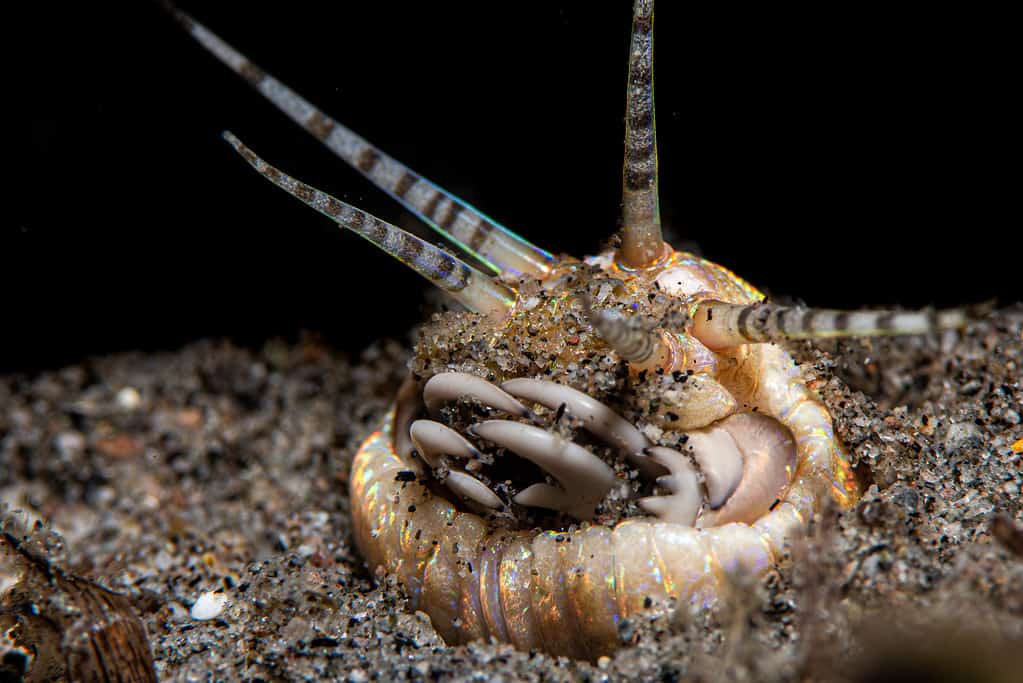
The Bobbit worm (pictured) is a very creepy critter, but also quite colorful with its iridescence.
©Jack Pokoj/Shutterstock.com
2. Giant Isopod
Species Classification: Bathynomus giganteus
Giant isopods are harmless types of invertebrate animals, scuttling about in the ocean’s depths and nibbling on dead items that have drifted down from above, despite how terrible they may appear to be. Bathynomus giganteus is a species of aquatic crustacean belonging to the Isopoda order. It belongs to the genus Bathynomus of gigantic isopods and is thus distantly related to shrimp and crabs. The giant isopod is benthic and common in cold waters in the Atlantic Ocean, including the Gulf of Mexico and the Caribbean, down to a depth of 7,020 feet.
The giant isopod’s body is segmented into three parts: a head, a thorax, and an abdomen, like the majority of crustaceans. They contain nearly 4,000 distinct facets in their enormous triangular compound eyes. They appear to glow when light reflects off the tapetum lucidum, a highly reflective layer located at the rear of their eyes. The giant isopod typically grows to a length of seven to 14 inches. These unsettling creatures resemble a giant hybrid of a pill bull, a crab, and a mythical sea monster.
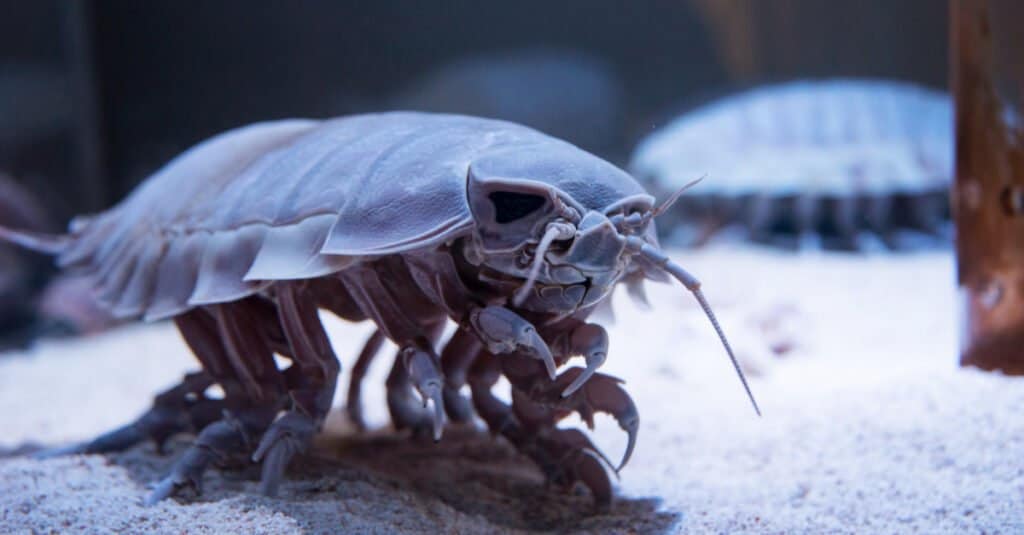
Giant isopods (pictured) are large, creepy invertebrates that are mostly found at the bottom of the Atlantic Ocean.
©kikujungboy CC/Shutterstock.com
3. Vampire Squid
Species Classification: Vampyroteuthis infernalis
If you’re scared of the ocean, the vampire squid will be another reason to avoid the water. These little cephalopods called vampire squids can be found in the deepest parts of temperate and tropical waters. To survive in these areas of the ocean with the least amount of oxygen, it makes use of its bioluminescent organs and special oxygen metabolism. It differs from octopi and squid by having two long retractile filaments that are situated between the first two pairs of arms on its dorsal side. As a result, it has its own order called Vampyromorphida.
These types of invertebrate animals have a pretty creepy appearance! The vampire squid can grow as long as one foot in total. Depending on the environment and illumination, its gelatinous body can range in color from velvety black to greyish red. Its eight arms are connected by a webbing of skin that is covered with rows of fleshy spines. Its opaque and globular eyes are enormous in comparison to the size of its body. Depending on the illumination, their eyes can be either opaque pale red or blue.
This animal’s black hue and cloak-like webbing, not its diet, served as the inspiration for its name. Instead of eating blood, the vampire squid consumes ocean detritus.

Vampire squid (pictured) may look fearsome, but they actually are quite harmless to humans.
©Emőke Dénes / CC BY-SA 4.0, via Wikimedia Commons – License
4. Amazonian Giant Centipede
Species Classification: Scolopendra gigantea
Scolopendra is the genus of centipedes that includes the Amazonian gigantic centipede. At a length of more than 12 inches, it is the world’s biggest species of centipede. Up to 21 or 23 segments are possible along these centipedes’ bodies. This species is spread out over South America and the southern Caribbean, where it feeds on a broad range of creatures, such as other arthropods, amphibians, mammals, and reptiles. This invertebrate is one creepy character!
In dark, wet areas like under leaf litter or beneath rocks, the Amazonian giant centipede can be found in tropical or subtropical rainforests as well as tropical dry forests. It is a carnivore that eats any other animal that it can dominate and kill with its brute strength and deadly venom. It is strong enough to defeat small vertebrates like lizards, frogs, snakes, bats, and even birds in addition to other invertebrates including insects, spiders, millipedes, scorpions, and even tarantulas. The venom of this centipede has caused at least one recorded human fatality. So, if you find yourself in the Amazon, be mindful of where you step!
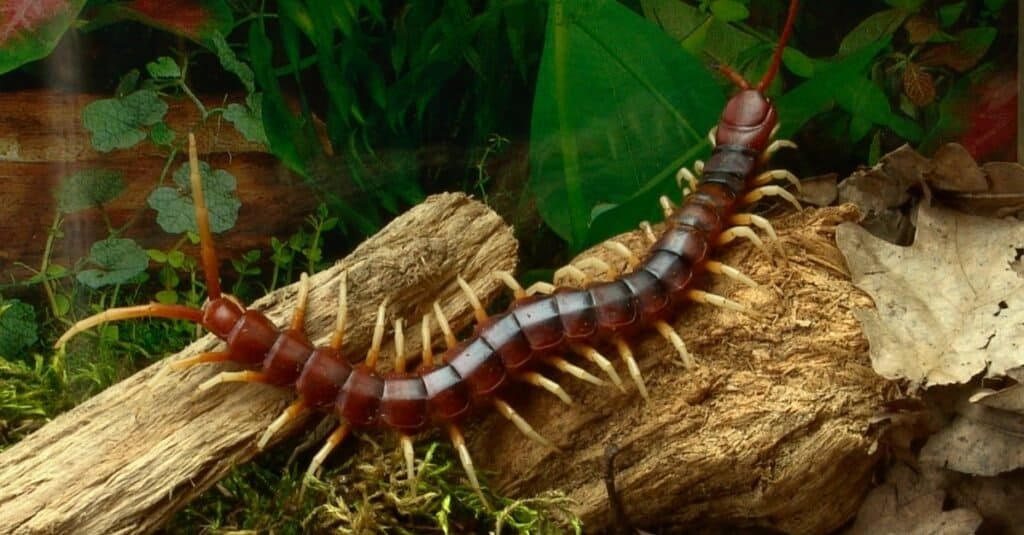
The Amazonian giant centipede (pictured) is an enormous invertebrate whose venom can be quite dangerous.
©skifbook/Shutterstock.com
5. Coconut Crabs
Species Classification: Birgus latro
The coconut crab, which is sometimes referred to as the robber crab, is a type of terrestrial hermit crab. At a weight of up to nine pounds, it is the biggest terrestrial arthropod in the whole world. From the tip of one leg to the tip of the other, it may grow to a width of up to three feet. It can be found on islands in the Pacific Ocean and the Indian Ocean. To put it simply, this creepy invertebrate is an enormous, terrifying-looking hermit crab. However, you won’t have to worry about the coconut crab putting you in danger. They are generalist scavengers that will eat everything from coconuts to dead animals to even rotting food in garbage cans, which they are sometimes found inside. That’s a pretty scary discovery, isn’t it?
The coconut crab, although it mostly lives in burrows, has been seen climbing coconut trees. No evidence has ever depicted a coconut crab collecting coconut fruit from these trees intentionally. However, they could knock over ripe fruit that would otherwise eventually fall. These crabs will also try to get away from humans or large marine bird predators by climbing. The coconut crab also has a keen sense of smell that it uses to find food.
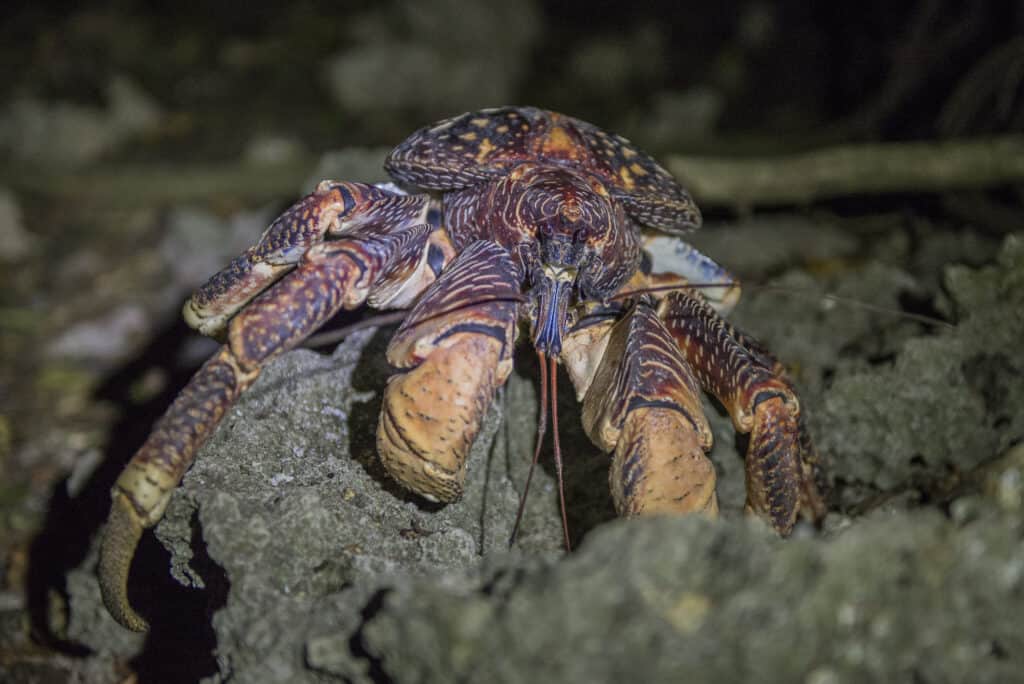
Coconut crabs (pictured) have a very keen sense of smell that works differently underwater and on land.
©iStock.com/Riccardo Maywald
6. Tailless Whip Scorpions
Species Classification: Amblypygi order
This creepy invertebrate is mostly harmless, but it really does look like something out of a horror movie. Arachnid chelicerate arthropods of the Amblypygi order are referred to as whip spiders or tailless whip scorpions. Amblypygids lack venomous teeth and silk glands. When threatened, they don’t often bite, but they can grip fingers with their pedipalps and cause puncture wounds that resemble thorn pokes. They can be found in tropical and subtropical areas all over the world. These creatures prefer warm, humid surroundings and prefer to hide out in leaf litter, caverns, or beneath treebark. All species of tailless whip scorpions are nocturnal
The tailless whip scorpion is distinguished by its long, spindly legs, two eerie-looking “arms,” and hefty, scorpion-like torso. And yes, they reach out to grab prey with these arms. These “arms” are actually modified pedipalps that are similar to that of a praying mantis. The length of these critters’ legs may measure up to six inches. The majority of species have eight eyes: two median eyes above the chelicerae at the front of the carapace, and two smaller clusters of three eyes each further back on each side.
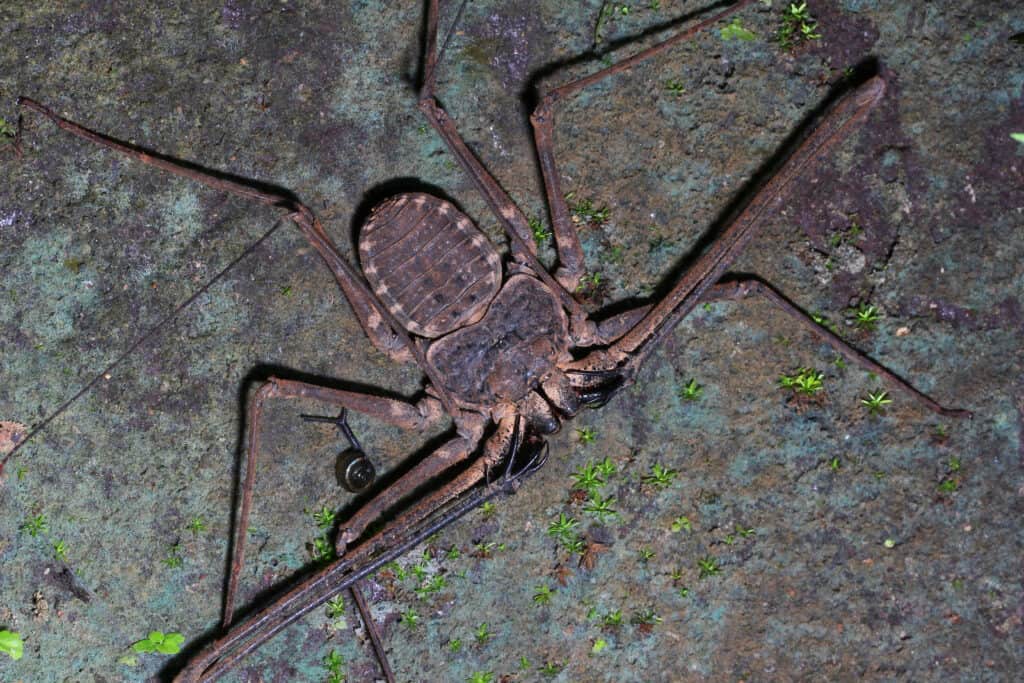
Tailless whip scorpions (pictured) have very long, bent pedipalps that they use to hunt and grab prey.
©Pong Wira/Shutterstock.com
7. Giant Weta
Species Classification: Deinacrida genus
Are you a fan of grasshoppers or crickets? No? Well, you might want to avoid the giant weta. It’s basically just an enormous cricket. The family Anostostomatidae, genus Deinacrida, has numerous species of wetas that are known as giant wetas. In fact, their genus name actually means “terrible grasshopper.” Fitting, no?
All except one of the indigenous giant weta species in New Zealand are legally protected because they are facing the danger of extinction. Bigger species, excluding their long, supple legs and antenna, can reach lengths of up to four inches. One of the biggest insects in the world, they can weigh up to two and a half ounces.
As humans started changing the New Zealand ecosystem, the majority of gigantic weta populations have been declining. As all but one species of gigantic weta are thought to be in danger of becoming extinct, they are all legally protected. The north of New Zealand is home to three arboreal giant weta species, which are now limited to areas without mammals. This is due to the fact that the introduction of mammalian predators, habitat degradation, and habitat change by imported mammalian insectivores are all to blame for the diminishing abundance of the majority of weta species, especially gigantic weta.
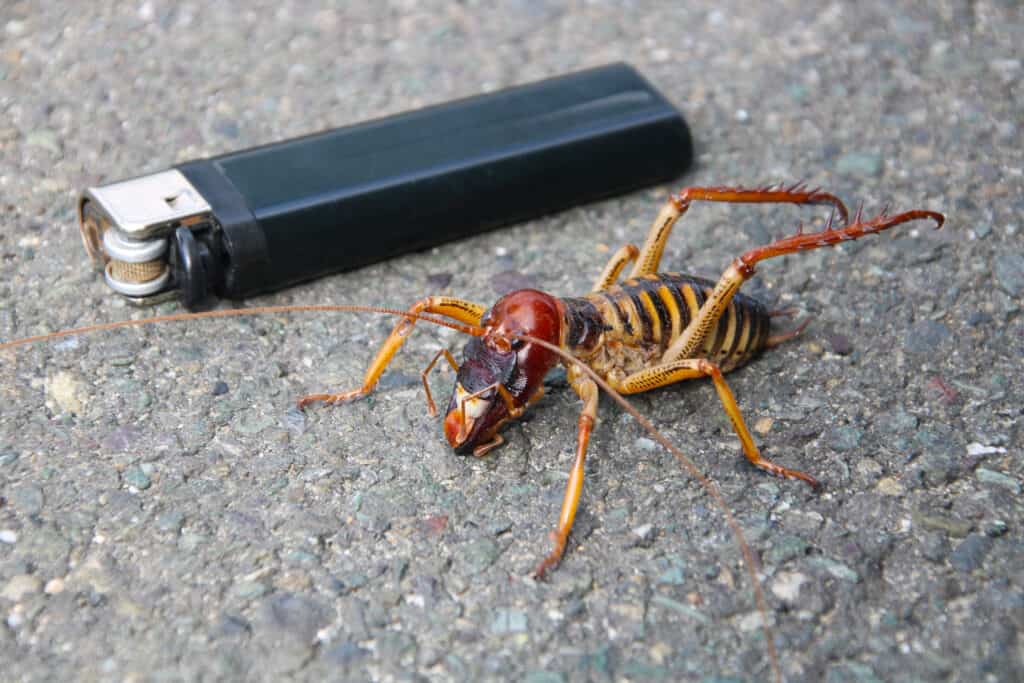
The giant wet (pictured) is a massive insect that is currently at risk of becoming endangered.
©rybarmarekk/Shutterstock.com
8. Bigfin Squid
Species Classification: Magnapinna genus
Now this is a sea creature you don’t want to stumble upon in the dark. The bigfin squid is a group of seldom encountered cephalopods with a unique shape. They belong to the family Magnapinnidae and the genus Magnapinna. While only larval, paralarval, and juvenile specimens were used to define the family, several video sightings of bigger squid with comparable appearances are thought to represent adult members of the same family. With observations as deep as 20,381 feet below the surface, Magnapinna is considered to be the deepest-occurring squid genus, making it the first and only squid known to live in the hadal zone.
This squid’s arms and tentacles can reach lengths of 13 to 26 feet. Elbows are formed when these appendages are held parallel to the body. To put it simply, the bigfin squid looks like some type of ancient alien creature.
The bigfin squid may eat by dragging its arms and tentacles around the bottom and snatching food invertebrates from there, according to scientific speculation. Or, they could just employ a trapping strategy by passively waiting for food to swim into their arms. Still, how this squid feeds is yet to be discovered. We’d rather not find out.
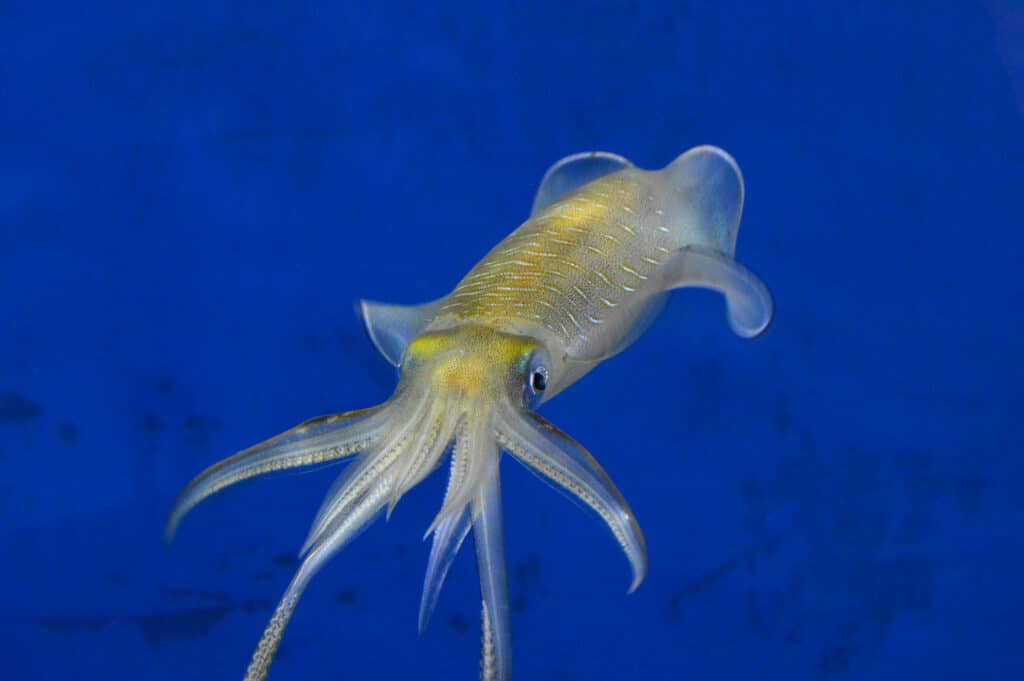
Footage of the bigfin squid is few and far between, but they are closely related to bigfin reef squid (pictured).
©iStock.com/kororokerokero
9. Japanese Spider Crab
Species Classification: Macrocheira kaempferi
Another creepy crab on this list is the Japanese spider crab. These types of invertebrate animals are the largest living arthropods in the world. It can easily span up to 13 feet when its legs are completely extended. Its spindly gams account for the majority of its breadth; the body itself is barely around a foot wide.
To reach its enormous size, the Japanese spider crab passes through three major larval phases and a prezoeal stage. These enormous crustaceans live in the Pacific Ocean around Japan at depths of up to 1,000 feet. The southern beaches of the Japanese island of Honshu, from Tokyo Bay to Kagoshima Prefecture, are where Japanese spider crabs are most often observed. These crabs resemble enormous spiders and have a rather ominous appearance.
Japanese spider crabs trudge down the ocean floor slowly in search of dead animal bits and living creatures to eat. Being an omnivore, the Japanese spider crab eats both plants and animals. It occasionally consumes dead animals in a scavenging manner. They are sought after by crab fishers and are prized in Japan. Overfishing is something that conservation initiatives seek to prevent for these creepy critters and their population.

Japanese spider crabs (pictured) are known for their creepy, long arms and legs that can reach 13 feet.
©LELACHANOK/Shutterstock.com
10. Irukandji Jellyfish
Species Classification: Carukia barnesi
These little rare jellyfish may not look particularly creepy. They’re adorable types of invertebrate animals, in fact. However, their creepiness lies in their deadliness. This species of box jellyfish has some of the most dangerous and potent venom in the world. Their venom can cause Irukandji syndrome, which is an extremely painful and lethal condition. Victims can experience pain, hypertension, and cardiac arrest when stung by this species.
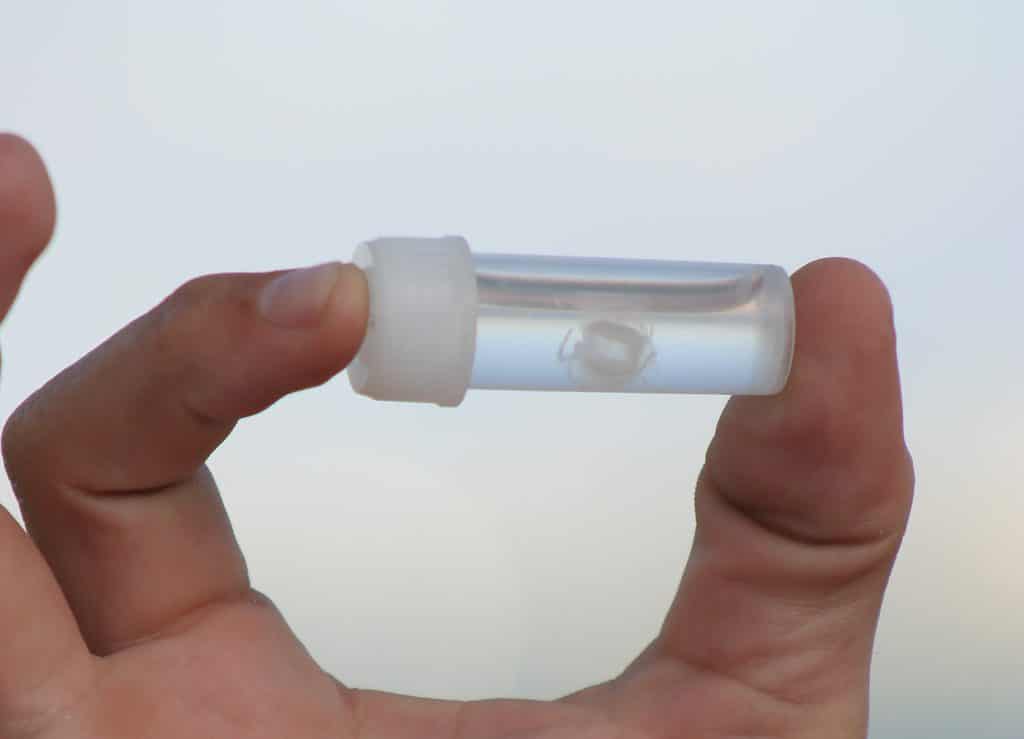
Irukandji jellyfish (pictured) are extremely tiny and dangerous jellyfish.
©2,221 × 1,606 pixels, file size: 596 KB, MIME type: image/jpeg – License
How crazy cool are these creepy types of invertebrate animals? Some of these animals might not live near you, while others may be creeping around in your own backyard. And since invertebrates make up 95% of animal species, you’ll probably be able to find some of them without looking too hard!
The photo featured at the top of this post is © K Hanley CHDPhoto/Shutterstock.com
Thank you for reading! Have some feedback for us? Contact the AZ Animals editorial team.






